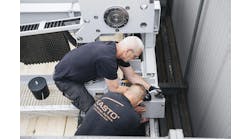One of the biggest challenges for manufacturers is ensuring that production lines perform at the highest capacity, void of downtime and quality control issues. Subjected to harsh and variable work environments—fluctuating temperatures, pressure and force—production equipment must adjust frequently to outside influences in order to maintain optimal performance, conserve energy and prevent waste.
To achieve this balance, manufacturers often turn to variable frequency drives (VFDs), which are designed to control motor speed and deliver more production flexibility and control. VFDs offer three key benefits.
2. Energy savings: If a motor continually runs at full capacity, there is the potential for significant electrical energy waste and, as a result, excessive costs. VFDs allow motor speed to match the load requirements and eliminate the waste associated with mechanical regulation such as a throttle valve. VFDs are available for motors of virtually any size.
3. Reduced wear and tear: Many motors function as either on or off—that is, they have one speed at which they run, even if the demand is much lower. This leads to equipment stress and a shorter shelf life. With a soft start capability, VFDs ease the mechanical stress of a full-voltage start. VFD systems can also run at lower speeds, which makes them less prone to overheating and therefore less likely to require maintenance.
However, there is one drawback to the use of VFD systems: electrical noise that can affect other pieces of equipment, ultimately disrupting the manufacturing process and contributing to downtime and quality control problems. The same switching technology that allows the motor to demonstrate speed flexibility can also create excess energy in the cable that may spill over into connected equipment. Without the proper grade of cable to contain this noise, significant issues may occur.
Also read: Wire and cable: A no-brainer?
So how can engineers capture the benefits of VFD cables while eliminating the associated issues? The answer lies in the construction and installation of the cable—connecting the system with the right grade of VFD cable and ensuring the proper shielding is present in the system to contain the noise. There are two main factors to consider when selecting VFD cables: design and installation.
Elements of cable design
[pullquote]When selecting a VFD cable, it’s critical to understand the entire system and what the cable will be required to handle in terms of current capacity, both now and in the future. A cable’s ability to mitigate the effects of VFD output is determined by its design—either construction grade or high performance—with the latter being better-suited to noise-sensitive environments.
Design considerations include copper levels, ground sizes, length of the cable and shielding material.
Grounding configuration: The grounding system should be designed to give the lowest possible ground path impedance. Using a 300% ground cable is the best way to ensure that the potentially harmful (common mode) noise current is contained by the cable and returned harmless to the drive.
Conductor design: Choose a conductor designed to conduct high-frequency signals. Such a conductor will have a high strand count, providing increased surface area, and tinned conductors for thermally stable connections.
Capacitance-high dielectric strength: Choose a cable with low capacitance and high dielectric strength. THHN or minimally compliant construction-grade VFD cables have higher cable charging losses and will build reflected wave voltages faster. Those same cables will have about one-third the insulation strength of a high-grade XLP conductor.
Shielding: The shielding material used in the cable greatly influences the noise that occurs. When the cable contains low-impedance shielding, there is less current reflection and greater system reliability. Again, look for a shield that has maximized surface area to ensure high-frequency performance. Dual copper tapes or braid will provide the best shielding performance.
High performance VFD cables have better grounding and shielding capabilities, and they provide more reliable and stable connections than the construction-grade options.
Installing a VFD cable
When installing a VFD system, it’s crucial to ensure that the cable does not degrade the system or contribute to issues with related equipment or other equipment in the facility. It is also critical to ensure that the cable will perform for the life of the system and stand up to the demands over time.
To help determine a proper match with the entire VFD system, engineers should ask the following questions: Is the environment noise sensitive? Are there instruments or networks that will be affected by noise currents or electromagnetic forces? Will cable charging currents be a consideration with longer cable runs?
If the answer is yes, a high-performance VFD cable with optimized stranding, grounds and insulation is the answer. If none of the above are true, then the user may consider a construction-grade VFD cable, but, even in that case, be sure to select a cable with an XLPE insulation to ensure improved electrical performance and long-term reliable operation.
Choosing a well-designed, robust VFD cable ensures motor uptime and reliability, and it provides protection for any sensitive instrumentation and adjacent control systems. The VFD system, including the motor and the required cabling, can be configured to support the needs of the production facility today and scaled to meet the needs of tomorrow.
Peter Cox is the director of global industrial projects for industrial cable at Belden. Contact him at [email protected].
Image courtesy of Danilo Rizzuti at FreeDigitalPhotos.net




